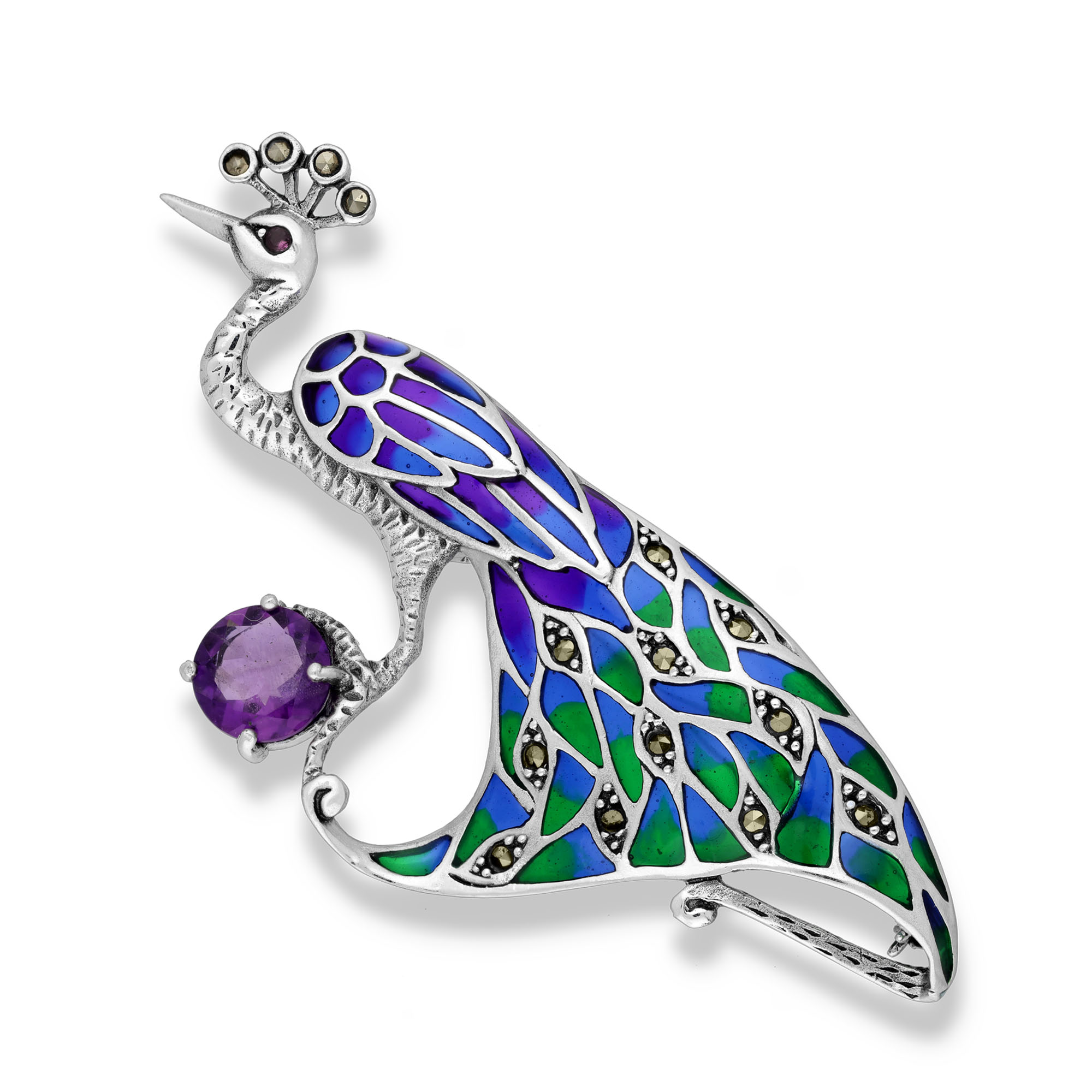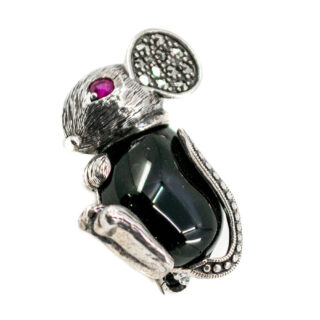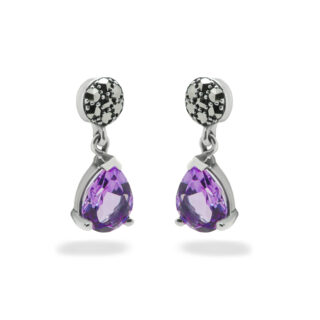This contemporary peacock brooch exudes grace, featuring a vibrant 2.00-carat round amethyst cradled by intricate plique-à-jour enamel in rich blues and greens. Accentuated by shimmering marcasites, the silver craftsmanship elevates this artistic design.
Details: ±2.00ct amethyst, enamel Plique-à-jour, Marcasites (pyrite), Silver Brooch.
Design Era: Contemporary.
Weight in grams: 9.7.
Condition: New.
Shipping and Pickup: This stylish piece ships from our store located in the center of Amsterdam, The Netherlands. We offer both registered shipping and local pickup at our store. In the case of local pickup, any applicable shipping costs will be refunded.
About Us: Add some sparkle to your style with Binenbaum.com. We offer a stunning selection of antique and vintage jewelry that you won’t find anywhere else. From timeless rings and dazzling necklaces to unique brooches, we have something for every taste and occasion. Visit our website today and treat yourself to a piece of history.
| Design Era | |
|---|---|
| Design & Historical Context | Contemporary jewellery is a type of jewellery that reflects current trends and styles, and is often made from a variety of materials beyond the traditional precious metals and stones. This allows contemporary jewellery to have a more modern and unique appearance compared to classic jewellery. To create contemporary jewellery, it is necessary to have both specialized training and a deep understanding of the subject. The contemporary style combines historical techniques and artistic expression with innovative ideas and materials, giving it a distinct personality that falls between fashionable mass-produced jewellery and traditional artisanal works of art. |
| Key Materials | |
| Materials & Craftsmanship | amethyst: The Stone of Tranquility and Elegance Amethyst, a striking violet gemstone from the quartz family, is cherished for its vibrant hues, ranging from soft lavender to deep purple. Formed in volcanic rocks and geodes, its rich color comes from iron and trace elements, enhanced by natural radiation over millions of years. Historically, amethyst has been prized by many cultures. The ancient Greeks believed it could prevent intoxication, naming it "amethystos," meaning "not drunk." It was also a symbol of royalty and spirituality, often used in crowns and religious artifacts during the Middle Ages. In modern jewelry, amethyst’s durability (Mohs hardness of 7) and stunning color make it a popular choice for rings, necklaces, and other pieces. Known as the "Stone of Tranquility," it is believed to calm the mind and enhance spiritual clarity. Amethyst is not just a beautiful gemstone; it carries a rich history and symbolism that adds depth to any piece of jewelry, making it a timeless and elegant choice. Plique-à-jour: The Art of Translucent Enamel and Timeless Beauty Plique-à-jour is a highly intricate and delicate enameling technique that has been revered for centuries for its ability to create stunning, stained glass-like effects in jewelry. The term "plique-à-jour" is French for "letting in daylight," which perfectly describes the way light passes through the translucent enamel, creating a luminous, ethereal quality. Historically, plique-à-jour was developed in the late Middle Ages and perfected during the Renaissance, particularly in the workshops of Italian and French artisans. This technique was often used to create exquisite pieces for royalty and the elite, including pendants, brooches, and other decorative objects. The process involves applying enamel within metal frameworks without a backing, allowing light to shine through the enamel when held up or worn, much like a miniature stained glass window. In modern jewelry, plique-à-jour continues to be celebrated for its extraordinary beauty and the skill required to create it. The technique is labor-intensive, as each section of the metal framework must be meticulously filled with enamel and then carefully fired to achieve the desired transparency and color depth. The result is a jewel that glows with color, with each piece being a unique work of art. Plique-à-jour is often used in high-end and bespoke jewelry, where its delicate, airy quality adds a touch of elegance and sophistication. Common motifs include floral designs, butterflies, and other nature-inspired themes, where the translucency of the enamel enhances the lifelike quality of the subject. Plique-à-jour is more than just a technique; it is a symbol of artistic mastery and timeless beauty. Its ability to capture and reflect light in such a captivating way makes plique-à-jour jewelry not only visually stunning but also deeply treasured for its craftsmanship and history. Whether featured in antique or contemporary designs, plique-à-jour continues to enchant and inspire those who appreciate the art of fine jewelry. Marcasite (pyrite): The Gem of Timeless Elegance and Vintage Charm Marcasite, often mistakenly referred to as pyrite, is a gemstone that has captivated jewelry enthusiasts for centuries with its metallic luster and vintage appeal. Although marcasite is technically a form of pyrite, true marcasite jewelry is made from pyrite crystals that are cut and polished to create a shimmering, antique look. Historically, marcasite has been admired for its mysterious, reflective surface, often used in intricate, filigree designs during the Victorian and Art Deco periods. In the 18th and 19th centuries, it became particularly popular in Europe as a more affordable alternative to diamonds, lending an air of elegance and sophistication to brooches, rings, and other accessories. In modern jewelry, marcasite is prized for its ability to add a touch of vintage charm and drama to any piece. Its metallic, gunmetal-gray hue pairs beautifully with silver settings, and its natural sparkle makes it a standout in both understated and ornate designs. Marcasite is commonly seen in rings, earrings, pendants, and brooches, often set in sterling silver to enhance its classic, antique look. Marcasite is more than just a gemstone; it is a symbol of timeless elegance and enduring style. Its historical significance and unique, reflective quality make it a cherished choice for jewelry that exudes both character and sophistication, perfect for those who appreciate the charm of vintage-inspired designs. Silver: The Metal of Elegance and Versatility Silver, known for its bright, reflective luster, is one of the most beloved and widely used precious metals in the world. This versatile metal has been cherished for thousands of years, not only for its beauty but also for its malleability, making it ideal for crafting intricate and delicate jewelry designs. Historically, silver has been associated with the moon and considered a symbol of purity, clarity, and protection. Ancient civilizations, from the Egyptians to the Greeks and Romans, valued silver for its beauty and used it to create coins, jewelry, and religious artifacts. In many cultures, silver is also believed to have healing properties, often used in amulets and talismans to ward off negative energy. In modern jewelry, silver is prized for its affordability, versatility, and timeless appeal. Sterling silver, an alloy of 92.5% pure silver and 7.5% other metals (usually copper), is the standard used in high-quality jewelry. Its durability and bright, reflective surface make it an excellent choice for a wide range of designs, from minimalist pieces to ornate creations. Silver can be polished to a high shine or given a matte, oxidized, or antiqued finish to suit various styles. Silver is more than just a metal; it is a symbol of elegance, flexibility, and understated luxury. Its enduring popularity and wide-ranging applications make it a staple in jewelry that can complement any look, from casual to formal, with timeless grace. |
| Gender | |
| Weight (in grams) | 9.7 |
| Condition |
Enhance the Beauty of Your Jewelry with Proper Care
Wearing your jewelry is a special way to express yourself and add a touch of personal style to any look. However, to ensure your jewelry remains in pristine condition, there are a few simple steps you need to take to keep it looking its best.
General Care Instructions:
Remove jewelry when showering or bathing, especially when at the beach, in the sea or in chlorinated water.
Avoid wearing jewelry while doing physical work such as housekeeping, gardening or exercise.
Storing your jewelry in a dry and cool place will help protect it from moisture, dirt and dust.
Keeping it away from harsh chemicals such as bleach, ammonia and chlorine will help to avoid discoloration and damage.
Cleaning your jewelry regularly with a soft cloth will help to keep it looking shiny and new.
Avoid exposing your jewelry to extreme temperatures, such as leaving it in direct sunlight or near a heater, as this can cause damage.
Handle your jewelry carefully and avoid dropping it, as this can cause the stones to loosen or the metals to scratch.
Finally, if possible, have your jewelry professionally checked and serviced. This will ensure that any potential problems are spotted and fixed before they become worse.
By following these tips, you can enjoy your precious jewelry for many years to come.
Related Products
-
Emerald Marcasite (Pyrite) Silver Cat Brooch 16226-2514
€ 225,00 VAT incl. (where applicable) -
Marcasite (Pyrite) Onyx Ruby Silver “Mouse” Brooch 16227-2515
€ 195,00 VAT incl. (where applicable) -
Marcasite (Pyrite) Pearl Silver Pendant Brooch 16215-2503
€ 395,00 VAT incl. (where applicable) -
Topaz Marcasite (Pyrite) Silver Deco Brooch 13118-1175
€ 295,00 VAT incl. (where applicable) -
Garnet Pearl Agate Marcasite (Pyrite) Silver Floral Brooch 13121-1178
€ 395,00 VAT incl. (where applicable) -
Agate Marcasite (Pyrite) Silver Cat Brooch 14273-1572
€ 195,00 VAT incl. (where applicable) -
Enamel Pearl Ruby Silver Butterfly Brooch 16216-2504
€ 225,00 VAT incl. (where applicable) -
Amethyst Marcasite (Pyrite) Silver Pendant Earrings 16431-2583
€ 165,00 VAT incl. (where applicable)
- Home
- Collection
- Fine Jewelry
- Silver Jewelry
- Silverware
- Boxes
- Candlesticks
- Salt and pepper shakers
- Miniatures
- Salt cellars
- Spoon Set
- Condiments
- Frames
- Napkin Ring
- Spoon
- Oddities
- Cups
- Vases
- Cutlery
- Serving Spoon And Cake Server
- Candlesticks
- Baskets
- Hanukkiah
- Spice Tower
- Yad
- Tea Set
- Sugar Castor
- Napkin Rings
- Wine Bottle Coaster
- Wine Stopper
- Tea Pot
- Jugs
- Rattles
- Hip Flask
- Miscellaneous
- Rings 💍
- About
- Contact














